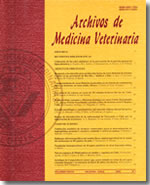Differential effect of chronic aflatoxin B1 intoxication on the growth performance and incidence of hepatic lesions in triploid and diploid rainbow trout (Oncorhynchus mykiss)
Main Article Content
Abstract
Triploid trout has been considered to be more resistant than diploid trout to many diseases and to some adverse aquaculture conditions. Considering the common problems with animal food contamination by aflatoxins, the purpose of this research was to compare the incidence of liver lesions and growth performance in triploid and diploid trout (O. mykiss) exposed to chronic contamination with aflatoxin B1.
A total of 240 samples formed 4 groups, diploid and triploid control without aflatoxin in food and diploid and triploid treated with 80 ppb of aflatoxin/Kg of food. Five samples in each group were monthly sacrificed during one year. After the measurement of body weight and length, hepatic samples were obtained and fixed in 10% formalin-saline solution. The histopathological analyses were performed with liver slides stained with hematoxylin and eosin.
The comparative analyses of the growth performance showed significant difference between control and treated diploid, suggesting that aflatoxin B1 affects the growing of diploid trout. In triploid groups this aspect was not observed.
The histopathological analyses indicated that triploid trout is more resistant to aflatoxin B1, since this group did not present neoplastic lesions. Diploid fishes however, showed 4 samples with neoplastic lesion. The triploid treated group had preneoplastic lesion, but with minor incidence and slower progression than diploid trout.

